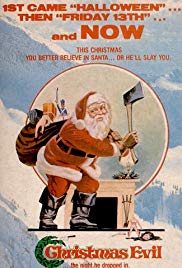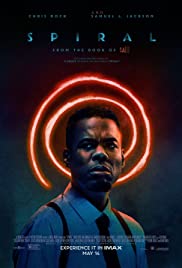
Christmas Evil (1980)
Directed by Lewis Jackson
Viewed on Shudder
That last Christmas horror movie, Black Christmas, was significantly better than I was expecting it to be, so now it’s time to take a look at another old-school Christmas horror classic. How to pick though, how to pick…how about we go with one recommended by the maestro of transgressive cinema, John Waters? The movie Christmas Evil has been described by Waters as “the greatest Christmas movie ever made.” So I think that means I am now obligated to see it. I do quite enjoy Christmas movies, so let’s see what made the top of Waters’ list. Time to explore some Christmas Evil!
Christmas Evil is the story of Harry Stadling, a boy obsessed with Santa Claus who grew into a man obsessed with Santa Claus. This all started when Harry was a young boy who, one Christmas Eve, saw Santa Claus (or rather his father dressed like Santa), descend down the chimney and perform a Santa Claus routine, leaving gifts under the tree and eating the food and drink left out for him. Harry and his younger brother Phil went to bed to wait for Christmas morning, but Harry heard a noise and went to investigate, stumbling upon his father, still dressed as Santa Claus, sensually groping his mother. The sight is a bit too much for Harry, who rushes upstairs and cuts his hand on glass from a broken snow globe. Years later, Harry is just as Santa obsessed, if not moreso, and, after a series of aggravating experiences with coworkers and neighbors, descends even further into his yuletide madness, slowly becoming the object of his obsession, Saint Nick.
Something you’ll figure out about the movie, if you look it up or see a plot summary of it somewhere, is that eventually Harry, in his Santa Claus persona, does kill people. Just reading the movie’s entries on Shudder and Amazon, you might think this happens immediately, but it’s just one small part of the movie. There aren’t even that many scenes where Harry kills people as Santa Claus. The majority of the movie is a psychological horror story following Harry’s descent into madness and his growing fixation on Santa Claus and his attempts to be like Santa.
This is a perfect movie for anyone who has ever thought that Santa Claus as a concept is a little creepy, and not in the ‘make believe person you lie to your children about’ way but in the ‘this self appointed judge watches all children all the time and that’s not okay’ kind of way. Most of the horror in the movie, for me at least, didn’t come from the last minute killing spree, but from seeing Harry fall deeper and deeper into his psychosis, aping the behaviors of Santa, like spying on children and keeping books dedicated to tracking their ‘naughty’ and ‘nice’ deeds and also having an apartment decorated solely with Christmas things. While the spying and the lists would probably always be creepy, Harry’s apartment is strange for two reasons, the first being that it is a little odd to see an otherwise sparsely furnished apartment just exploding with Christmas decorations, dolls, and images of Santa Claus prominently displayed, presumably year round, because it isn’t Christmas yet, it’s not even Thanksgiving! Secondly, it’s because of the unique look of the movie.
Everything has this grimy, grungy feeling to it, as if this whole world is just constantly soaked in grease and it’s collecting all this gunk. That’s kind of an odd visual, but that’s the best way I can describe it. Everything in this world just looks slightly off, and that gives shots a sort of strange edge to them, especially the things we see in Harry’s apartment. I wouldn’t bat an eye at an apartment filled with Christmas decorations, god knows my apartment has those in it right now, but because of this dark gritty filming style everything looks vaguely threatening and gloomy. It’s a great effect, and one that systematically enhances everything disturbing and frightening we see.
As well as being a creepy film, there is also a clever satirical edge to a good deal of what happens. Harry works at a toy factory, having just been promoted to middle management from his position on the assembly floor, and as such we occasionally hear Harry talk about toys, specifically his dissatisfaction with the toys that his company, Jolly Dreams, produces. His dissatisfaction comes from his knowledge that the toys that Jolly Dreams produces are of substandard quality, made from cheaply produced plastics and easily broken, clearly putting profits above the quality of the products and the enjoyment of the children who would be playing with these toys.
Harry also overhears, at the corporate Christmas party, that a young executive came up with a holiday toy drive plan, that promises to give some toys to a local hospital for the disabled, but only if the workers increase productivity and donate some of their own money, as well. Shockingly, Harry doesn’t like this plan very much. What this adds up to is a neat satirical edge, that criticizes corporate behaviors that we still see today, cutting quality in order to make cheaper products, putting pressure on workers to work harder so that the company can do better without offering any incentive to do so, except holding those same cheap toys hostage from a charitable donation unless the workers do so. Harry’s anger at his company, increased because of their use of Santa as a mascot, helps push him over the edge and it’s really interesting to see a movie about Christmas kind of tackle the consumerist conflicts that a gift giving holiday like Christmas has.
Large chunks of the movie have this satirical aspect to them, commenting not only on consumerism and corporate culture but also on many other aspects of Christmas traditions, like Santa passing judgements on others, rewarding or punishing behavior as he deems fit, and also how children react to Santa, or people dressed like him. There’s a great scene late in the movie that zeroes in on a parental fear that I hadn’t seriously thought about, and that is the anonymity that a Santa suit gives you. Kids are drawn to Santa, because why wouldn’t they be, and unless you personally know the person in the suit, you have no idea what their intentions are or even who they are. I don’t want to give away too much about this scene in particular, but it handles the topic in a clever way.
Why I’m focusing so much on the satire, though, is that for as much as I enjoyed Christmas Evil, I understand that the reasons I like it could be reasons that some people dislike it. The pacing here is a bit methodical; events of great importance don’t happen every scene, so it’s much more of a gradual build up to a payoff rather than a constantly exciting plot. I am completely okay with this, but I could see how this could alienate some viewers. Along with that, the killing spree doesn’t happen until very late in the movie, which is more the fault of the advertising than the film itself, but that’s another reason Christmas Evil could feel rather slow. Even with a more methodical pacing though, Christmas Evil definitely succeeds as a film and has one of the greatest movie endings I’ve ever seen.



Recent Comments